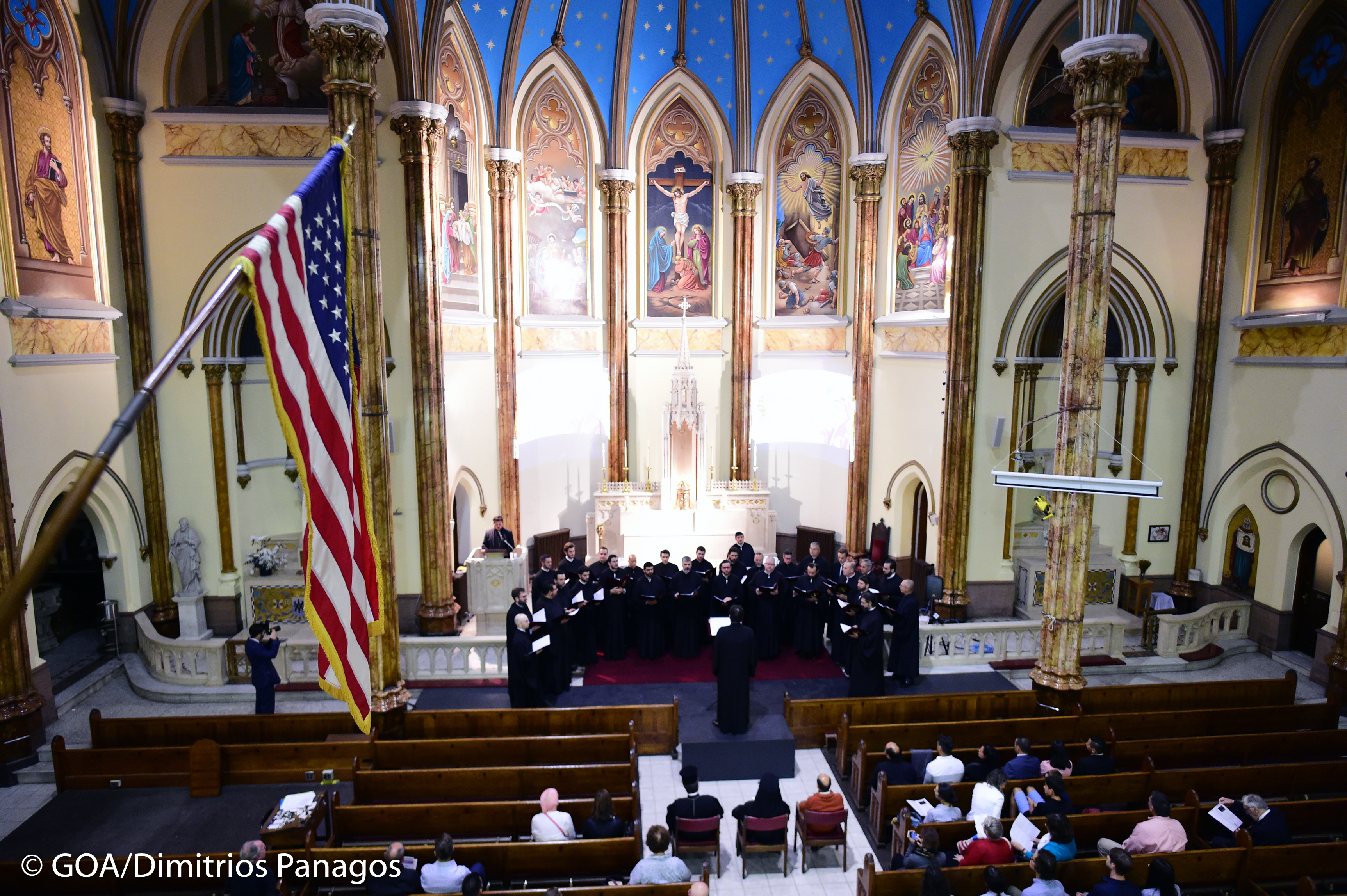Archdiocesan Byzantine Choir at St. Veronica 9/11

H.E. ARCHBISHOP DEMETRIOS GERON OF AMERICA IN ATTENDANCE AT THE CONCERT AT ST. VERONICA CHURCH IN NYC PERFORMED BY THE ARCHDIOCESAN BYZANTINE CHOIR DIRECTED BY DEMETRIOS KEHAGIAS. © GANP/DIMITRIOS PANAGOS
By: Vicki James Yiannias
On September 11, the day of the remembrance of all those lost in the terrorist attacks and the St. Nicholas Greek Orthodox Church, the only house of worship destroyed at ground zero 17 years ago in New York City, a performance of the Archdiocesan Byzantine Choir at St. Veronica Church in downtown Manhattan inaugurated the new, free, music series, Sounds of the Great Religions. His Eminence Archbishop Demetrios of America and Bishop Sevastianos attended.
When cultures and religions uncomprehending of each other are thrown together in figuratively tight spaces the language of music can be a means of communication. This significant initiative from George Capsis, forward-thinking publisher of the free publication, Westview News, is a promotion for future understanding. The concerts are free and open to the public.
In his Welcome, Capsis said that the “dramatic, almost theatrical interior space of St. Veronica Church invites imaginative uses” and it inspired this series of concerts, “a survey of great musical moments from the world’s great religions telling the story of the Greek Orthodox Church from Constantine the Great to Today.”
The 37-member choir includes Demetrius Kehagias, the Director, Rev. Dn. Panteleimon Papadopoulos, Managing Director, Archdeacon Panteleimon, who gave a short historical narrative about the Orthodox Church and the importance of the Byzantine Empire, especially Constantine the Great, for the spread of Christianity throughout the Mediterranean, and Rev. Dn. Romanos Karanos, Professor of Byzantine Musicology.
The performance also marked the beginning of the Eastern Orthodox Ecclesiastical Year.
It was a musical and iconographic overview of the major feasts within the Orthodox Liturgical Calendar with a primary focus on Christocentric Feasts. Each feast was complimented with a short explanation of what is celebrated and why it is important, through an analysis of the hymns chanted and their theological importance.
Beginning with the achingly evocative hymn to the City of Constantinople, “O Theotokos, I, your city”, for which His Eminence and His Grace stood, the audience following suit, the Byzantine Archdiocesan Choir has perfect unity of sound and outstanding solo chanters.
The other hymns: What shall we offer you, O Christ?… 2nd Mode; 9th Ode of the Canon for the Feast Entrance of the Lord into the Temple; As many of you as were baptized… 1st Mode; The Great Prokeimenon of the Great Forty-Day Fast… Plagal 4th Mode; Matins of Great Friday — They stripped me of my garments… Plagal 2nd Mode; CANON of Pascha (Selected verses)… 1st Mode; Heavenly King… Plagal 2nd Mode; The Great Doxology (select verses)… Grave Mode.
St. Veronica Catholic Church on Christoper Street was built, as was the original St. Nicholas Greek Orthodox Church downtown, by seamen—in the case of St. Veronica, Irish seamen, who began its construction in 1890. In this period of intensified, more frequent contacts between the Orthodox and the Catholic Churches on the topic of unity, the stark contrast between the brightly-colored Western (after the Renaissance) paintings in the apse of St. Veronica and the large-scale projections of Byzantine icons next to them, the different scales of Byzantine chant and Western music, with their obvious differences provided interest.
This concert seemed to be as instructionally thoughtful as possible. As an introduction to every hymn being chanted a corresponding Byzantine icon was projected large-scale next to the church’s paintings high up on the apse. At the bottom of the icon, in English, was a description of the icon and a short analysis of the hymn, making it very easy to follow what the choir was singing and its significance within Orthodox theology and liturgical practice.
Byzantine hymnology, musical scale and notation, and Byzantine iconography—all of which His Eminence Archbishop Demetrios helpfully explained in his Closing Remarks—gave those unfamiliar with Orthodoxy, as well the Orthodox in the audience, a beginner’s survey that surely might encourage follow-up interest in the beauty of the Church.
The concert ended with a solemn focus on the tragic events of 9/11.A 6-minute video, a special tribute showing the reconstruction of Saint Nicholas Greek Orthodox Church and National Shrine was shown. A hymn from the Orthodox funeral service was chanted in commemoration of the day with hymns to St. Nicholas.
Remembering all of those lost on that tragic day 9-11-2001. May their memories be eternal.
To view the Concert click here!
Archdiocesan Byzantine Choir Members
Demetrios Kehagias, Director
Rev. Fr. Romanos Karanos, Professor of Byzantine Musicology at
Hellenic College and Holy Cross Greek Orthodox School of Theology
Rev. Dn. Panteleimon Papadopoulos, Managing Director
Rev. Fr. Antonios Papathansiou * Rev. Fr. Andreas Houpos * Rev. Dn. Eleftherios Constantine
Nektarios Antoniou * Alexandros Avgeris * Richard R Barrett * Theodore Brakatselos * Luis Camacho * Panos Coufos * Eustratios Gatanas * Gregory Gatanas * Nick Gregoriades * George Kazoulis * Anthony Ladas * Yianni Mavrogiannis * Demetrios Michael * Sotirios Michalatos * Anastasios Mirisis * Dimosthenis Papaioannou * Nicholas Paros * George Rallis * Neophytos Sarigiannis * Pavlos Sotirelis * Panayiotis Steele * Christos Strubakos * George Theodoridis * Yannis Tziligakis * Evaggelos Zaharatos
Read more...
